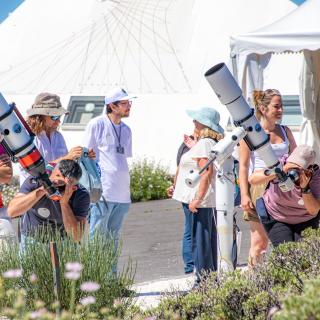It may interest you
-
 El Observatorio del Teide recibe este fin de semana a cerca de 1.000 visitantes en sus tradicionales Jornadas de Puertas Abiertas, organizadas por el Instituto de Astrofísica de Canarias (IAC) con motivo del solsticio de verano. Esta iniciativa, ya consolidada en el calendario divulgativo del IAC, ofrece a la ciudadanía la oportunidad de acercarse a la ciencia y a las infraestructuras científicas de Canarias de forma directa y cercana. La actividad está coordinada conjuntamente por el propio Observatorio y por la Unidad de Comunicación y Cultura Científica (UC3) del IAC, en el marco de lasAdvertised on
El Observatorio del Teide recibe este fin de semana a cerca de 1.000 visitantes en sus tradicionales Jornadas de Puertas Abiertas, organizadas por el Instituto de Astrofísica de Canarias (IAC) con motivo del solsticio de verano. Esta iniciativa, ya consolidada en el calendario divulgativo del IAC, ofrece a la ciudadanía la oportunidad de acercarse a la ciencia y a las infraestructuras científicas de Canarias de forma directa y cercana. La actividad está coordinada conjuntamente por el propio Observatorio y por la Unidad de Comunicación y Cultura Científica (UC3) del IAC, en el marco de lasAdvertised on -
 This Saturday, 29 March 2025, the Instituto de Astrofísica de Canarias (IAC) was able to follow the partial solar eclipse from the Teide Observatory in Tenerife. Although subtle to the naked eye, this eclipse was used by the IAC's outreach team to raise awareness of the phenomenon among a group of people from the ‘Friends of the IAC’ programme and IAC staff. At the same time, an observation was also made from the IAC Headquarters in La Laguna, which could be seen live on the centre's YouTube channel. The eclipse began at 09:14 UT and ended at 10:56 UT, with its maximum at 10:03 UT. For justAdvertised on
This Saturday, 29 March 2025, the Instituto de Astrofísica de Canarias (IAC) was able to follow the partial solar eclipse from the Teide Observatory in Tenerife. Although subtle to the naked eye, this eclipse was used by the IAC's outreach team to raise awareness of the phenomenon among a group of people from the ‘Friends of the IAC’ programme and IAC staff. At the same time, an observation was also made from the IAC Headquarters in La Laguna, which could be seen live on the centre's YouTube channel. The eclipse began at 09:14 UT and ended at 10:56 UT, with its maximum at 10:03 UT. For justAdvertised on -
 The international CTAO LST Collaboration , in which the Instituto de Astrofísica de Canarias (IAC) plays a prominent role, released remarkable findings from observations of GRB 221009A—the brightest gamma-ray burst (GRB) ever recorded. The results were published by the renowned journal The Astrophysical Journal Letters (ApJ Letters) . The publication presents in-depth observations conducted in 2022 with the Large-Sized Telescope (LST ) prototype, the LST-1, during its commissioning phase at the Roque de los Muchachos Observatory (ORM) on the CTAO-North site in La Palma, Spain. TheAdvertised on
The international CTAO LST Collaboration , in which the Instituto de Astrofísica de Canarias (IAC) plays a prominent role, released remarkable findings from observations of GRB 221009A—the brightest gamma-ray burst (GRB) ever recorded. The results were published by the renowned journal The Astrophysical Journal Letters (ApJ Letters) . The publication presents in-depth observations conducted in 2022 with the Large-Sized Telescope (LST ) prototype, the LST-1, during its commissioning phase at the Roque de los Muchachos Observatory (ORM) on the CTAO-North site in La Palma, Spain. TheAdvertised on